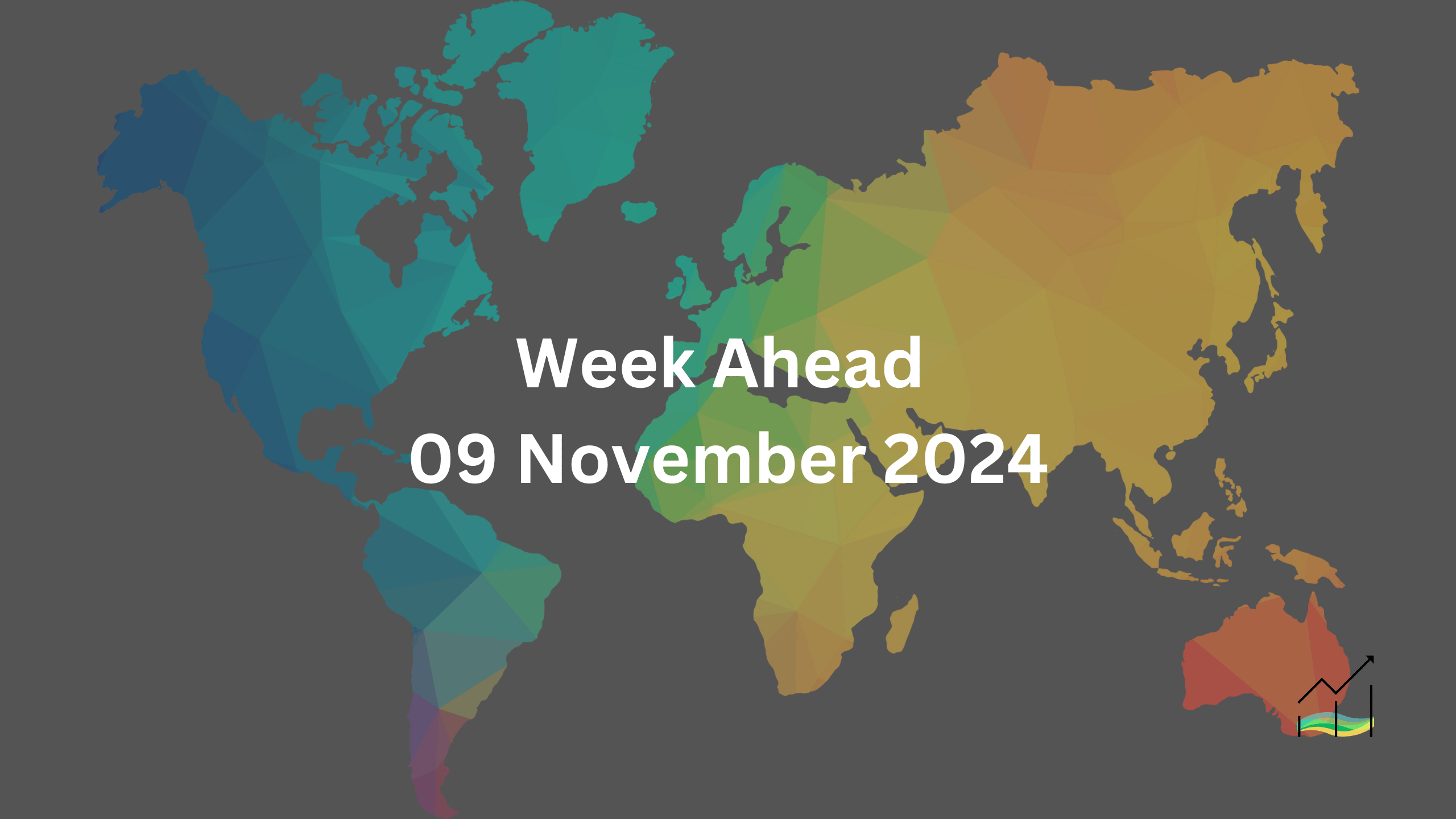09/11/2024 Week Ahead

A Look Ahead
In the upcoming week, the financial world will closely watch U.S. inflation and retail sales data, two key indicators for understanding consumer demand and price pressures. Investors are still weighing the broader impact of the recent GOP electoral win, which has stirred debates over economic policy direction and market response. Federal Reserve Chair Powell has taken a firm stance, reinforcing that the Fed’s goals remain on employment and price stability, regardless of political shifts.
Across the Pacific, China’s economy takes the spotlight with a stream of new data. Markets will assess these figures for signs of recovery and any emerging policy shifts, particularly as global trade tensions simmer. Japan’s economic growth report will also garner attention, especially as the political landscape evolves with the LDP’s Ishida likely taking the helm in a minority-led government. These data points will reveal much about Asia’s economic trajectory and potential impact on global markets.
In Europe, Germany’s political uncertainty has increased following the recent dismissal of Finance Minister Linder. The pressure for earlier elections is mounting, posing potential risks to the Euro and investor sentiment across the Eurozone. Meanwhile, key U.S. data, such as October’s Consumer Price Index, will reveal inflation’s latest direction, while Q3 GDP from the UK and Japan, along with Australia’s employment data, will provide further clarity on the global economic landscape.
With consolidation characterizing recent U.S. dollar strength, markets may remain volatile. The lessons from 2016–2020 about policy unpredictability and negotiation tactics resonate again, leaving investors to balance optimism with caution amidst political and economic complexities across the globe.
United States of America
Fed Balances Inflation with Employment Goals
Federal Reserve officials are optimistic that inflation is progressing toward the 2% target, which allows them to refocus on the employment mandate. The Consumer Price Index (CPI) remains critical, though it now competes with the nonfarm payroll report. October’s CPI may edge up, with an anticipated monthly increase of 0.2% and a possible year-over-year rise to 2.5%. This would mark the first year-over-year increase since March. Core CPI is expected to be stickier, with a 0.3% monthly rise for the third consecutive month, potentially bringing the annual rate to 3.4%.
Rising Inflationary Pressures from Producer Prices
Producer price inflation appears to have accelerated in October, reinforcing inflationary pressures. Key reports on October’s retail sales and industrial production will provide additional insights. Auto sales improved, with a seasonally adjusted annualized pace of 16.04 million units, the highest since May 2021. Retail sales may show a 0.3% gain after September’s 0.4% increase. Industrial production, however, is expected to contract by 0.2%, marking the sixth decline in 2024 as economic growth slows from Q3’s 2.8% to a projected 1.7% for Q4.
Interest Rate Movements Challenge Markets
U.S. interest rates have risen sharply since late September, with the two-year yield increasing by nearly 80 basis points and the 10-year yield by almost 90. The yield curve, which inverted at the end of Q2, has re-inverted slightly, presenting challenges for businesses and banks. This rapid shift in rates signals heightened market sensitivity to economic data and policy outlooks.
Dollar Index Reacts to Election Results
The Dollar Index fell to a two-week low as Americans voted, but spiked to a four-month high the next day, hinting at potential bullish consolidation. Last Wednesday’s trading range (104.00–105.45) is key, with 2024’s high at 106.50 now in sight, suggesting continued dollar strength amid policy uncertainty.
Economic Uncertainty Following Trump’s Election Win
Following Donald Trump’s election victory, the market response reflects expectations of inflationary pressures from anticipated trade tariffs and tax cuts. U.S. Treasury yields and the dollar have risen sharply, mirroring market expectations for potential changes to Fed rate policy. Analysts now await Wednesday’s CPI inflation data for October, which could shape the Fed’s interest rate outlook.
Fed’s Changing Stance on Inflation
Seema Shah, Principal Asset Management’s chief global strategist, notes a shift in the Fed’s tone, suggesting a cautious approach toward inflation. While another rate cut may occur in December, Shah views the outlook beyond that as uncertain, particularly if Trump’s policies increase inflation pressures. October’s CPI inflation is forecasted to rise above September’s 2.4%, driven by base effects.
Key Points:
- CPI and Core CPI: Expected monthly uptick may drive Fed policy decisions.
- Producer Price and Industrial Output: Indicators of potential inflation and industrial weakness.
- Retail Sales: A modest rise would reflect consumer resilience.
- Interest Rates and Dollar Movements: Continued volatility signals market caution.
Australia & New Zealand
Wages and Employment Outlook
Australia will release its Q3 wage index on November 13, followed by October’s employment report on November 14. Wage growth, which accelerated in 2022 and 2023, appears to be moderating this year. For the first half of 2024, wage increases averaged around 0.85% quarterly, marking the slowest pace since early 2022, in contrast to pre-pandemic averages of 0.55%. Job growth remains robust, with 373,500 new jobs created through September, compared to 317,000 in the same period last year. Full-time employment made up a significant portion, with 291,000 full-time roles added this year compared to 143,000 last year. Given this backdrop, the Reserve Bank of Australia (RBA) seems in no rush to adjust interest rates, with market projections suggesting the first rate cut around April 2025.
Australian Dollar’s Slight Gains Amid Modest Market Sentiment
The Australian dollar saw a small uptick last week—the first since late September—although its price action remained uninspiring, settling below Thursday’s low around $0.6565. The Aussie may have been bolstered by the RBA’s reluctance to join other central banks in monetary easing, Australia’s stable relationship with the U.S., and its economic ties with China. However, support for the currency remains fragile, with key support levels around $0.6470–$0.6500.
Employment Strength and Implications for Rate Policy
October employment data, set for release on Thursday, will be highly anticipated by bond traders. Economists have repeatedly underestimated the strength of Australia’s labour market, and another strong report could be in store. Unemployment remains near historic lows, with labour participation at record highs despite the broader economic slowdown. Job creation has been fueled partly by robust hiring in the healthcare sector. If employment continues to surge, the RBA may face challenges in justifying an early rate cut, even though many economists predict a cut in February, while others forecast a delay until mid-2025 or later. Recent RBA statements have shown little inclination towards lowering the Official Cash Rate anytime soon.
New Zealand Economic Highlights
New Zealand will release the Reserve Bank of New Zealand (RBNZ) Survey of Expectations on Monday and housing price data from REINZ on Thursday, adding to the regional economic insights for the week.
Key Points:
- Australia’s Q3 Wage Index: Moderating wage growth could influence RBA’s policy direction.
- October Employment Report: Job strength may impact bond markets and shape rate cut expectations.
- Australian Dollar Support Levels: Potential market movements with critical support around $0.6470–$0.6500.
- New Zealand’s Economic Data: RBNZ expectations and housing data for additional regional economic context.
Canada
Bank of Canada’s Rate Outlook and Political Uncertainty
The Bank of Canada (BoC) has already reduced its target rate by 125 basis points this year. Market expectations suggest a 50% chance of an additional 0.5% cut at next month’s meeting. However, recent data and political developments make the outlook more uncertain. October’s PMI increased from a low of 47.0 to 50.7, signalling some improvement in the economy. However, Canada faces ongoing challenges, including a weak currency, continued port strikes, and rising political tensions. The Bloc Quebecois and Conservatives are working to destabilize the minority Liberal government, though the NDP remains opposed. These developments complicate the BoC’s decision-making process.
U.S. Dollar Strength and CAD Weakness
Last week, the U.S. dollar gained momentum, rising from CAD 1.3820 to a yearly high of CAD 1.3960. This uptick in the dollar is expected to continue as the market digests the aftermath of the U.S. election. Additionally, the yield premium on U.S. two-year bonds over Canadian bonds reached 115 basis points, the highest in 27 years. This trend further supports the greenback’s strength. If USD/CAD breaks through the 1.4000 level, it would mark the highest point since May 2020, signalling a potential for further gains.
Key Points:
- The Bank of Canada faces political and economic uncertainty, making further rate cuts less likely.
- Strong PMI data indicates economic resilience, but political risks persist.
- The U.S. dollar continues to outperform the Canadian dollar, with a potential break above CAD 1.4000 in sight.
China
Impact of Beijing’s Economic Initiatives
Beijing’s recent economic initiatives are beginning to show an impact on China’s high-frequency economic data. October’s PMI exceeded expectations, but inflation data revealed a mixed picture. The Consumer Price Index (CPI) slowed to 0.3% year-over-year, down from 0.4%, while the Producer Price Index (PPI) dropped 2.9%, slightly worse than the previous month’s decline of 2.8%. Food price inflation also slowed, from 3.3% to 2.9%, while the core inflation rate inched up to 0.2% from 0.1%. As more data is released in the coming days, we expect to see signs that the decline in property prices may be slowing, while industrial production and retail sales could show improvement. Although property investment remains weak, residential sales may be starting to stabilize. Investors are still looking for more government initiatives to support the economy.
U.S. Dollar Outlook Against the Yuan
The U.S. dollar appears poised for further gains against the Chinese yuan. The greenback could soon test the CNH7.25 level against the offshore yuan, which has not been seen in three months. If this trend continues, the dollar may approach CNH7.30, a level last reached in July. However, this modest move will likely not offset the tariffs that President Trump has threatened. In response to yuan depreciation, the People’s Bank of China (PBOC) set the dollar’s reference rate sharply lower last Thursday, indicating its readiness to manage the yuan’s weakness.
October Growth Indicators for China
Economists expect China’s consumption, investment, and industrial output to have grown faster in October, as Beijing’s stimulus efforts begin to take effect. Retail sales data, due Friday, November 15, is anticipated to show an annual growth of 3.7%, up from September’s 3.2%. Fixed-asset investment is also expected to rise 3.5% for the January-October period, slightly above the 3.4% increase seen in the first three quarters. Industrial production is projected to have picked up to a 5.6% growth in October, compared to 5.4% in September.
Housing Market Trends and Stimulus Developments
Housing price data will be closely watched for signs of stabilization, with recent reports indicating that sales may be picking up. In addition, China’s Singles’ Day event, often compared to Black Friday in the U.S., is expected to provide further clues on consumption trends. ING economists anticipate continued solid growth during the event. Moreover, markets will be focusing on further stimulus announcements, particularly after China’s top legislative body approved a local government debt swap program, though it did not provide the fiscal stimulus details that many were hoping for. Some economists, like Danske Bank’s Allan von Mehren, believe that China will keep increasing stimulus until a sustained improvement in the economy is seen. However, doubts remain about whether policymakers will take the necessary steps.
Key Points:
- Beijing’s stimulus initiatives are starting to influence economic data, but more is needed.
- The U.S. dollar is likely to strengthen further against the Chinese yuan, possibly reaching CNH7.30.
- Key data, including retail sales, industrial production, and housing market trends, will provide insights into the effectiveness of China’s stimulus.
- Stimulus measures and Singles’ Day will be closely watched for clues on future economic performance.
Europe
Industrial Output Weakness in the Eurozone
Industrial output in Germany, France, and Italy all showed significant declines in October. Germany reported a -1.0% drop, France saw a -0.6% fall, and Italy’s industrial output decreased by -0.5%. This weakness in the aggregate data for the eurozone is expected, and the forthcoming release on November 13 is unlikely to surprise markets. Despite the disappointing industrial figures, with Q3 GDP revisions already scheduled for November 14, the impact on market sentiment is expected to be limited.
Eurozone Economic Forecast Update
At the end of the week, the European Commission will release its updated economic forecast, and this may provide additional insights into the eurozone’s economic health. Markets will also be looking ahead to the ECB’s final meeting of the year on December 12. The swaps market currently prices in a modest chance of a 50 basis point rate cut, with roughly 83 basis points of easing priced in over the next three meetings, indicating a roughly 33% chance of a half-point move.
Legal Challenge in Germany Over Solidarity Tax
On November 12, Germany’s Constitutional Court will hear arguments regarding the legality of the solidarity tax, which was applied to almost all German taxpayers until changes in 2020 reduced its scope, exempting around 90% of taxpayers. This legal challenge could have broader political implications, as the government itself is facing internal turmoil following the dismissal of Finance Minister Lindner, who represented the FDP party in the coalition. Chancellor Scholz prefers a March election, but opposition parties, including CDU/CSU, are pushing for an earlier vote.
Euro’s Decline Amid U.S. Election Aftermath
Following the re-election of U.S. President Donald Trump, the euro sharply declined, falling from around $1.0935 to below $1.0665. The euro failed to recover, with the US two-year premium over Germany surpassing 200 basis points, signalling continued downward pressure on the euro. The low for the euro was set in mid-April near $1.06, and the currency fell by 1.2% last week, marking its biggest weekly loss in five weeks.
ZEW Indicator and German Economic Outlook
The ZEW economic sentiment indicator, due on Tuesday, will provide a snapshot of investor sentiment in Germany, especially following the collapse of the German coalition government. HSBC economists anticipate mixed results, with the current situation component likely to improve, driven by an upside surprise in Q3 GDP. However, expectations may continue to decline, as concerns about global trade tensions overshadow positive news from China.
Eurozone Data and Inflation Reports
On Tuesday, Germany will release its final inflation data for October, providing further insight into the country’s price pressures. Additionally, second-estimate GDP growth data for the eurozone will be published on Thursday, after the flash estimate showed a 0.3% quarterly expansion in Q3. Flash estimates for eurozone employment and industrial production will also be released on Thursday. French and Italian CPI data are expected on Friday, with additional focus on the ECB’s meeting minutes.
Upcoming Eurozone Bond Auctions
Germany will hold bond auctions this week, including a €5 billion auction for December 2026 Schatz on Tuesday and a €4 billion auction for August 2034 Bund on Wednesday. Other eurozone nations, including the Netherlands, Italy, and Portugal, will also be conducting bond auctions this week.
Key Points:
- Weak industrial output in the eurozone is expected, with limited market impact.
- ECB’s upcoming meetings and economic forecasts will be closely watched for signs of easing.
- Germany faces political challenges and legal questions over the solidarity tax.
- The euro faces continued downside risks after Trump’s re-election.
- ZEW indicator and inflation data will provide insights into Germany’s economic outlook.
- Upcoming eurozone GDP, employment, and inflation data will set the tone for the region’s economic trajectory.
Japan
Bank of Japan’s Next Move on Interest Rates
Many economists and investors are expecting the Bank of Japan (BoJ) to raise interest rates in the near term. As such, the market will be closely watching the summary of opinions from the BoJ’s October 30-31 policy meeting, set to be released on Monday. While the BoJ left its policy rate unchanged in the October meeting, it indicated that the economy is moving in line with its projections, leaving many to speculate on when the next rate hike may occur.
Japan’s Economic Growth Outlook for Q3
Japan’s economy is likely to have expanded modestly in the third quarter, driven by a recovery in consumption supported by higher wages. Government data scheduled for November 15 is expected to show real GDP growth of 0.2% from the previous quarter or 0.6% on an annualized basis, according to a poll of economists. This growth comes amid a challenging global environment but is reflective of a rebound in domestic consumption.
Japan’s Government Bond Auctions This Week
The Ministry of Finance is set to auction 250 billion yen of 10-year inflation-indexed bonds on Monday and 900 billion yen of 30-year sovereign debt on Wednesday. The auction of super-long Japanese government bonds may attract demand from long-term Japanese investors, such as insurance companies and pension funds, who seek stable, long-term returns in a low-interest-rate environment.
Current Account Surplus vs. Trade Deficit
Japan continues to report a growing current account surplus but struggles to recycle the surplus through capital outflows. The country’s current account surplus has been running about 50% higher than the previous year, with an approximate JPY19.7 trillion surplus through August. However, Japan has also been running a trade deficit, averaging nearly JPY3.5 trillion through August. The current account surplus is mainly supported by tourism revenues and returns from past investments, such as profits and royalties, while the trade deficit reflects declining exports.
Japan’s Investment Flows and Foreign Activity
Despite the growing current account surplus, Japan has seen a decline in the pace of capital outflows by its investors, who are buying foreign assets at a rate roughly half of last year’s pace. Conversely, foreign investors have been net buyers of Japanese assets in 2024, after being net sellers in the first ten months of 2023. This shift in foreign investment flows may have implications for the yen and broader Japanese financial markets.
Q3 GDP Estimate and Political Developments
Japan’s first estimate for Q3 GDP is due on November 15, with growth expected to slow from nearly 3% annualized in Q2 to about 1.5% in Q3. Slower consumption and investment are contributing factors, though government spending may have increased. In terms of political developments, Japan’s prime ministerial vote could take place as early as November 11. The ruling Liberal Democratic Party (LDP) is expected to reelect its current prime minister, though the coalition will need to secure support from other parties to pass key legislation.
Impact of US Election on USD/JPY
The US dollar surged to nearly JPY155 following the US election, reaching its highest level since late July. However, as US rates consolidated, so did the exchange rate. In the week following the election, the USD/JPY pair traded within a range of approximately JPY151.30-JPY154.70. Despite a slight 0.20% dip, the momentum indicators have turned lower, suggesting potential sideways movement in the pair. This marks a reversal from a five-week streak of dollar strength against the yen.
Key Points:
- The Bank of Japan’s summary of opinions will offer clues about the timing of future interest rate hikes.
- Japan’s economy is expected to show modest growth in Q3, with higher wage-supported consumption contributing to the expansion.
- The Japanese government is set to auction significant bond amounts, attracting long-term domestic investors.
- Japan’s current account surplus continues to grow, though the country runs a trade deficit.
- Japanese investment flows are slowing, while foreign investors are buying Japanese assets.
- Q3 GDP growth is expected to slow, and political developments may impact the leadership in Japan.
- The USD/JPY exchange rate has consolidated following a post-election surge in the US dollar.
United Kingdom
Bank of England’s December Policy Decision
The Bank of England’s (BoE) decision in December is unlikely to be influenced by the upcoming jobs report and Q3 GDP data. The ongoing slowing of wage growth continues to affirm the direction of monetary policy, allowing the BoE to implement two rate cuts earlier this year. The swaps market anticipates about 50 basis points of cuts in the first half of 2025. The UK economy contracted in the second half of 2023 but showed a strong recovery in the first half of 2024, with 0.7% growth in Q1 and 0.5% in Q2. The Q3 GDP report, due November 15, is expected to show a slowdown to 0.3%, but the year-over-year growth rate could be around 1%, the strongest since Q4 2022.
Sterling’s Ongoing Struggles
Sterling continued to decline for the sixth consecutive week, with no weekly gains since the end of September. Despite a 0.5% uptick heading into the pre-weekend session, the downward pressure on the currency remains. The post-US election low of around $1.2835 remains in play, and a break below $1.2800 could signal further losses, possibly extending toward the August low of $1.2665. The $1.3000-$1.3050 area is now seen as a key resistance zone for any potential recovery.
Rate Cuts and Economic Outlook
The BoE’s decision to cut interest rates in November suggests a cautious approach, given the solid economic conditions and recent fiscal policies that could stoke inflation. However, further rate cuts are expected to be gradual as the central bank balances the need to support growth with concerns over inflationary pressures.
Upcoming Economic Data
Key data releases in the coming week will shed light on the UK economy’s performance. This includes the jobs and wages figures on Tuesday, the provisional estimate of third-quarter GDP on Friday, and the RICS house price index for October, scheduled for release on Thursday. These data points will provide important insights into the health of the UK economy as policymakers consider further rate cuts.
Debt Auctions to Watch
The UK Debt Management Office is set to sell the October 2043 gilt on Tuesday and the March 2028 gilt on Wednesday. These bond auctions will be watched closely by market participants for indications of investor sentiment regarding UK debt.
Key Points:
- The Bank of England’s policy decision in December is expected to be influenced by ongoing wage growth trends rather than short-term data.
- Sterling continues to face downward pressure, with the $1.2800 level a key support to watch.
- Further rate cuts from the BoE are likely but will be gradual due to solid economic performance and inflationary risks.
- Upcoming data on jobs, wages, and GDP will provide clues on the UK economy’s trajectory.
- The UK Debt Management Office’s bond auctions will be important for understanding market sentiment toward UK debt.
© 2025 SKONE Enterprise (003319453-V). All rights reserved.
The content on this site is for informational purposes only and does not constitute financial advice.


